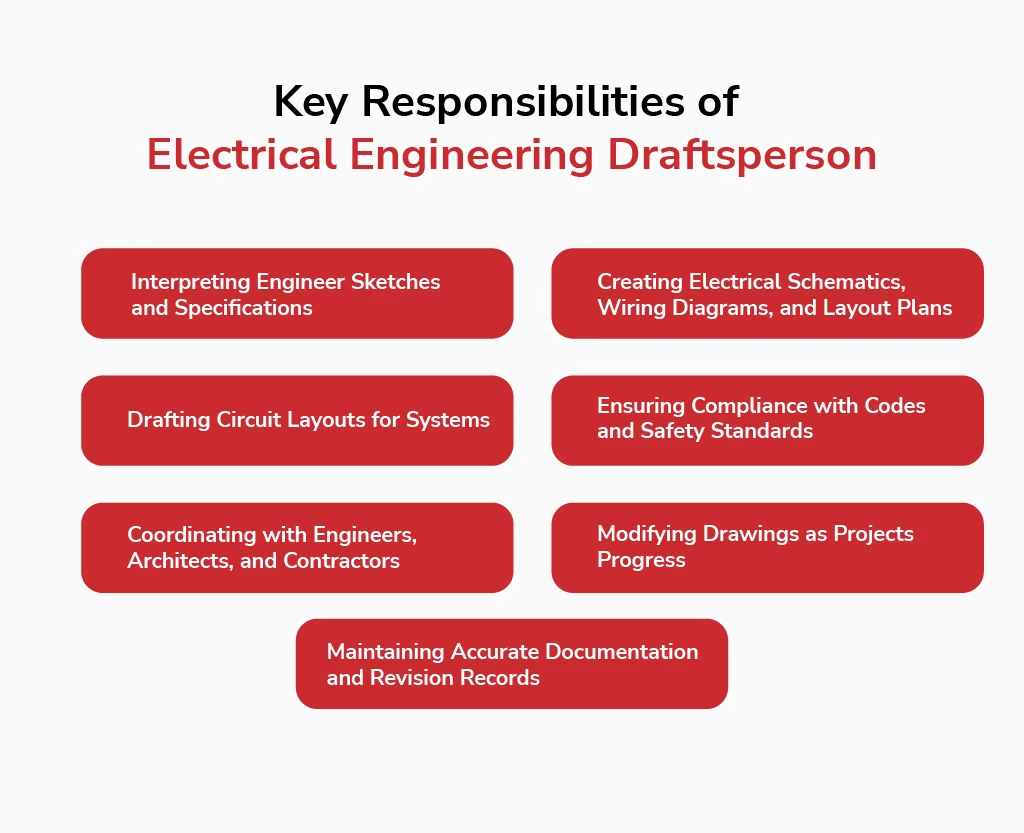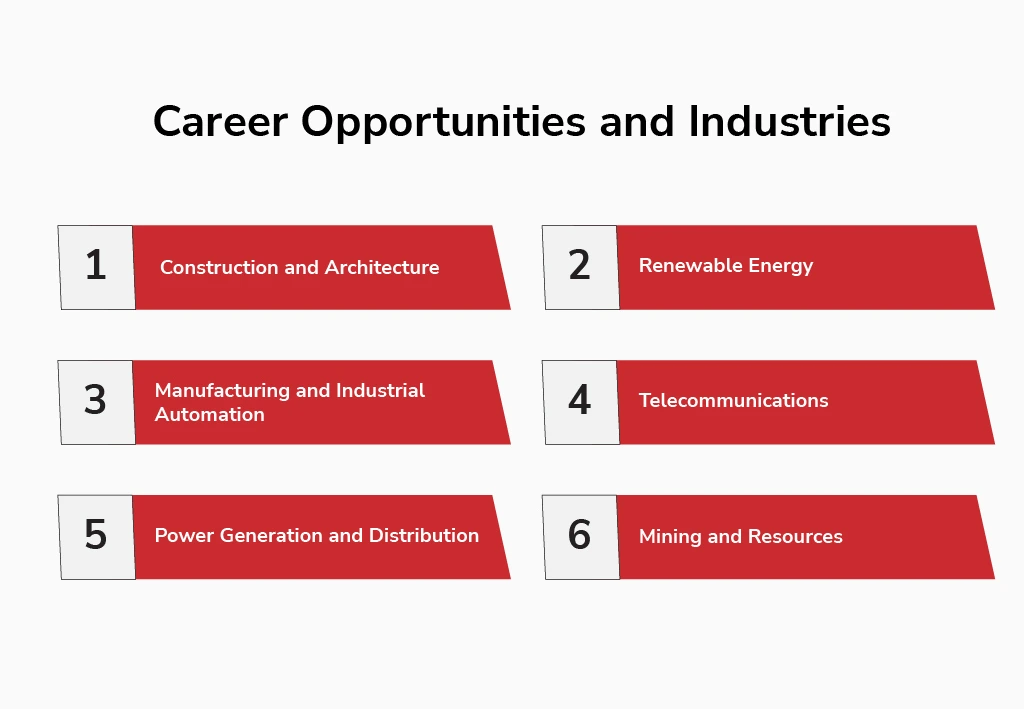What is an Electrical Engineering Draftsperson? Full Guide

What is an Electrical Engineering Draftsperson? Full Guide
Engineering today requires precise procedures and detailed planning. The electrical engineering draftsperson is among the professionals essential for achieving success in intricate electrical project outcomes. Engineers develop system designs, but draftspersons interpret these concepts into complete, accurate technical drawings and blueprints that become reality.
This document provides detailed information about electrical engineering draftspersons, including their responsibilities, necessary skills, educational requirements, professional growth potential, and role in overall engineering development.
Electric engineering draftspersons represent the professional role of producing technical drawings of electrical systems.
🔑 Key Highlights
- An electrical engineering draftsperson prepares technical drawings for electrical systems through software programmes based on designs from engineers.
- The main responsibilities of an electrical draftsperson include preparing wiring diagrams and schematics and layout plans while ensuring compliance with building standards and safety codes.
- Industry Applications: The construction sector, along with renewable energy and manufacturing and telecommunications and power distribution, all require the essential services of electrical draftspersons.
- Career Opportunities: Electrical engineering drafters have strong market demand from Australian and international energy projects, as well as smart technology implementation and infrastructure expansion.
What is an electrical engineering draftsperson?
Electrical engineering draftspersons deliver technical drawings that display electrical system installation methods along with maintenance and modification procedures. Constructing detailed drawings enables electricians, along with engineers and construction teams, to utilise them as blueprints.
An electrical engineering draftsperson uses computer-aided design (CAD) software to transform electrical engineer-provided idea sketches and specifications into accurate drawings, alongside working with these engineers directly.
The designing process results in diagrams for wiring, as well as circuit layouts and power distribution systems and electrical schematics that serve various residential, commercial, and industrial applications.
What Does an Electrical Engineering Draftsperson Do?
The role of an electrical engineering draftsperson is to create precise drawings and designs for electrical systems, while going by the title of electrical drafter. The drawings function as building blocks for electric system setup as well as operation and fix procedures across various concentration environments such as construction sites and infrastructure initiatives.
Professional drafters from the electrical engineering field take engineers’ initial drawings and specifications to create exact, detailed, standardised plans that direct electricians and other collaborators.
Key Responsibilities of Electrical Engineering Draftsperson

1. Interpreting Engineer Sketches and Specifications
The draftsperson starts their work by receiving fundamental electrical design ideas, which come through drawings or written descriptions and verbal explanations from the electrical engineers.
An engineer informs the drawing team by stating that an office floor requires a lighting circuit, followed by basic schematic information. The draftsperson develops an exact configuration by defining cable routes along with control and fixture positions, as well as power delivery methods.
Competent drafters are required to comprehend electrical fundamentals, such as voltage distribution and current flow, before developing concrete solutions from conceptual plans.
2. Creating Electrical Schematics, Wiring Diagrams, and Layout Plans
The drafting process includes working on electrical schematics as well as wiring diagrams, and layout plan creation.
The fundamental task of drafters constitutes their main responsibility in their profession. The staff at EIE uses software programs such as AutoCAD Electrical or Revit MEP to generate these products.
- The drawings display logical circuit relationships through schematic diagrams that function similarly to circuit mapping.
- The physical wire flow alongside its connection points is shown through wiring diagrams.
- Electrical cabinet panels, together with control system drawings, fall under the panel layout category.
- Lighting and power plans represent an essential component of residential as well as commercial or industrial building designs.
Drawings for industrial applications require such exactness that millimetre accuracy becomes standard for translating into actual construction projects.
3. Drafting Circuit Layouts for Systems
- Power distribution systems and control system panels are among the specialised circuits that electrical drafters design.
- Electrical distribution systems serve as the infrastructure that sends power from central supply points to all outlets and operational machines.
- Emergency lighting, together with dimming control features, is part of the lighting systems.
- Fire alarms and security systems
- The drawing of telecommunication systems includes internet networks and phone lines paired with data cabling systems.
The draftsperson needs to understand every code and specific requirement on account of the different systems.
4. Ensuring Compliance with Codes and Safety Standards
Building compliance with all necessary codes and safety standards constitutes the fourth responsibility.
Every country, as well as some regions, maintains unique electrical system standards that require compliance (e.g., the US and AS/NZS 3000 in Australia/New Zealand).
The draftsperson must ensure that:
- The selected wires match the expected safety demands of current electrical usage.
- All safety equipment, including circuit breakers and grounding mechanisms, exists in the system.
- The positioning scheme must comply with both the needed space dimensions and fire protection rules.
- Technical drawings need to obey municipal laws in addition to building construction requirements.
Wrong information can cause the failure of inspections, along with safety issues that may delay construction work.
5. Coordinating with Engineers, Architects, and Contractors
An electrical draftsperson functions within a project group that consists of several professionals, including
- Systems receive their design from electrical engineers.
- The architects establish building layout structures while working alongside other architects.
- The team includes mechanical engineers whose task is to coordinate with other teams regarding HVAC and plumbing systems.
- Construction teams implement designs from the drafted plans for building projects.
A draftsperson needs continuous interaction and communication with their team to handle problems that require preventing duct conflicts with plumbing or HVAC elements and to update drawings when other team members produce alterations.
6. Modifying Drawings as Projects Progress
A series of modifications occurs regularly during electrical design development due to these three main reasons:
- Client feedback
- Site changes during construction
- Equipment substitutions
- Code updates
Drafters have to maintain a complete track of modifications and maintain file organisation while updating plan illustrations. Revision clouds and notes appear frequently in drawings to mark all changes made to the design.
7. Maintaining Accurate Documentation and Revision Records
Construction and engineering projects must contain detailed documentation because this information will serve both present-day operations and upcoming inspection requirements and expansion needs.
The draftsperson:
- The draftsperson maintains all drawings in systematic file directories.
- The system stores reports about approval decisions with complete details on reviewers and time stamps.
- Every modification of documents includes version tracking through numbered versions or dated revisions.
- Draftspersons generate drawings that show the actual constructed elements.
The recorded information enables troubleshooting of electrical problems and system development in the future.
Career Opportunities and Industries

Electrical engineering draftspersons hold skills that adapt effortlessly to different professional fields. Drafters find their role in any industry because every operational system depends on electrical power for functioning; therefore, these specialists are needed to devise or document system designs. Each industry requires a different explanation about electrical engineering drafters.
1. Construction and Architecture
Electricians working on construction sites prepare full-scale wiring designs that illustrate the structural electrical systems for buildings. Together with architects and engineers, they ensure electrical components such as lighting systems, together with outlets and security equipment and backup generator units, receive safe, proper placements in design.
2. Renewable Energy
Experimental energy projects involving solar farms, wind turbines and battery storage components have electrical drafters as their development personnel. Drawing services from electrical drafters include the design of power conversion networks, together with electrical grid interface connections.
3. Manufacturing and Industrial Automation
The role of electrical drafters in manufacturing consists of designing factory electric systems, together with manufacturing control panels and automation circuit setups.
4. Telecommunications
Telecom drafters focus on designing power distributions needed for data centres as well as mobile towers and fibre-optic networks throughout the network infrastructure. Professional work responsibilities for drawings include schematics of communication room cables together with UPS elements and grounding system components.
5. Power Generation and Distribution
The role of electrical drafting involves designing electrical systems while documenting them for power plants together with transformer stations and distribution networks. Presenting their work consists of preparing one-line designs and offering relay control drawings and substation architectural diagrams.
6. Mining and Resources
Electrical systems in mining operations manage to power large equipment, together with ventilation systems and lighting equipment, as well as communication infrastructure, which operates in distant and dangerous environments. Drawers generate layout designs that incorporate underground wiring together with motor control centres as well as explosion-proof systems.
Conclusion
Electrical Engineering A draftsperson fulfils an essential function during the successful execution of electrical system plans across different industrial sectors. Engineering draftspersons carry out duties extending far beyond basic diagram creation since they function as connectors that transform design ideas into implementable electrical plans that meet construction standards.
The work performed by electrical engineering draftspersons ensures safe operations while maintaining the efficiency and functionality of buildings, as well as infrastructure and industrial systems. Due to increasing national priorities involving smart technologies, together with renewable energy and infrastructure development, skilled electrical drafters have emerging career prospects.
People with electrical design talents, attention to detail and interest in system electrics can find professional growth together with career stability through this specialised occupation, which benefits vital real-world projects.
FAQs
1. What is a draftsperson in electrical engineering?
Using CAD software, an electrical draftsperson prepares technical drawings that provide instructions for electrical system designs. Technical drawings from drafters serve as directives for wiring setup and maintenance operations, along with power system and circuit installation based on engineer-made designs.
2. What are the duties of an electrical engineer draftsperson?
An electrical engineer draftsperson is responsible for:
- Creating detailed electrical drawings and schematics using CAD software
- Interpreting engineers’ designs into technical plans
- Preparing layout drawings for wiring, circuits, and panels
- Ensuring designs meet safety codes and industry standards
- Updating and revising plans based on project changes or feedback
3. What does an engineering draftsperson do?
Such professionals draw advanced technical designs from engineering specifications through CAD programmes to back up industrial and building initiatives.
4. What is the code for an electrical draftsperson in ANZSCO?
The ANZSCO codes assigned for electrical engineering draftsperson work are 312311.
5. How many types of draftsmen are there?
There are several types of draftsmen, some of them are as follows:
- Architectural Draftsman
- Civil Draftsman
- Mechanical Draftsman
- Electrical Draftsman
- Structural Draftsman
- Electronics Draftsman
- Aeronautical Draftsman

 Chat with us
Chat with us